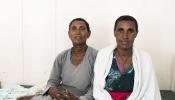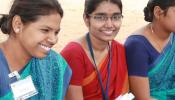A special post from Cambodia by Dr. Gary Barth, ophthalmologist
Today in Battambang, Cambodia Dr. Heng Ton and I were screening 17 villagers, mostly women, brought in by a Battambang Ophthalmic Care Centre (BOCC) van from a village 90 km away. One of the ladies that came by van had an interesting story to tell.
She had been blind for years and had no expectations of ever regaining her sight. She had no money and lived a long way from the nearest city. In Cambodia, with so few ophthalmologists, opportunities were limited to restore her vision.
Then one day, like a miracle, this happy 80 ear old saw “light” again. She celebrated the return of light but discriminating acuity was terrible. Nevertheless it was suddenly bright for the first time in many years.
What had happened was that her opaque cataract in her right eye had become “hyper-mature” and had dislocated into the vitreous gel in her eye. The hyper-mature cataract process is somewhat akin to an “overripe fruit” spontaneously dislocating from a fruit tree. Unfortunately, the natural lens of the eye serves a crucial optical function by focusing the rays of light to land on the retina.
Modern-day cataract surgery patients in Cambodia and elsewhere have an intraocular lens implanted at the time of cataract removal to replace the optical function of the natural lens. Without an implant, the best this still happy patient could see was only a "counting fingers" type of acuity. She could at best see the outline of the faces of her many grand and great-grandchildren.
The first recorded history of cataract surgery starts in India 600 years BC with practitioners of the art of "cataract couching." In this now “barbaric” procedure, patients had a practitioner use a bird’s sharpened quill to poke the opaque cataract back into the gel cavity of the eye- in short "couch" the cataract out of the way.
Our effervescent lady was delighted to learn that both her opaque cataract in her blind left could be removed and an implant placed later today. Secondly, she would be a candidate, if she wanted, to come in for an intraocular lens implant in her right eye to focus the bright rays of light she was enjoying. Her smile shows her reaction.
While on the topic of implants, one of the reasons that charity clinics such as BOCC can perform high-quality, low-cost cataract surgery is that they obtain their implants for $3.00 apiece from a Seva/Aravind Eye Hospital initiative to manufacture world class lenses in India and ship them to NGO clinics throughout the world at low prices.
Prior to Aravind being able to manufacture implants, they had to be purchased from western for-profit companies at 10 times the price. Throughout Asia and Africa, these lost cost implants extend the gift of sight to those that could not otherwise afford the for-profit implants. For more information about the manufacture of these implants go to: www.globalenvision.org/library/10/943


